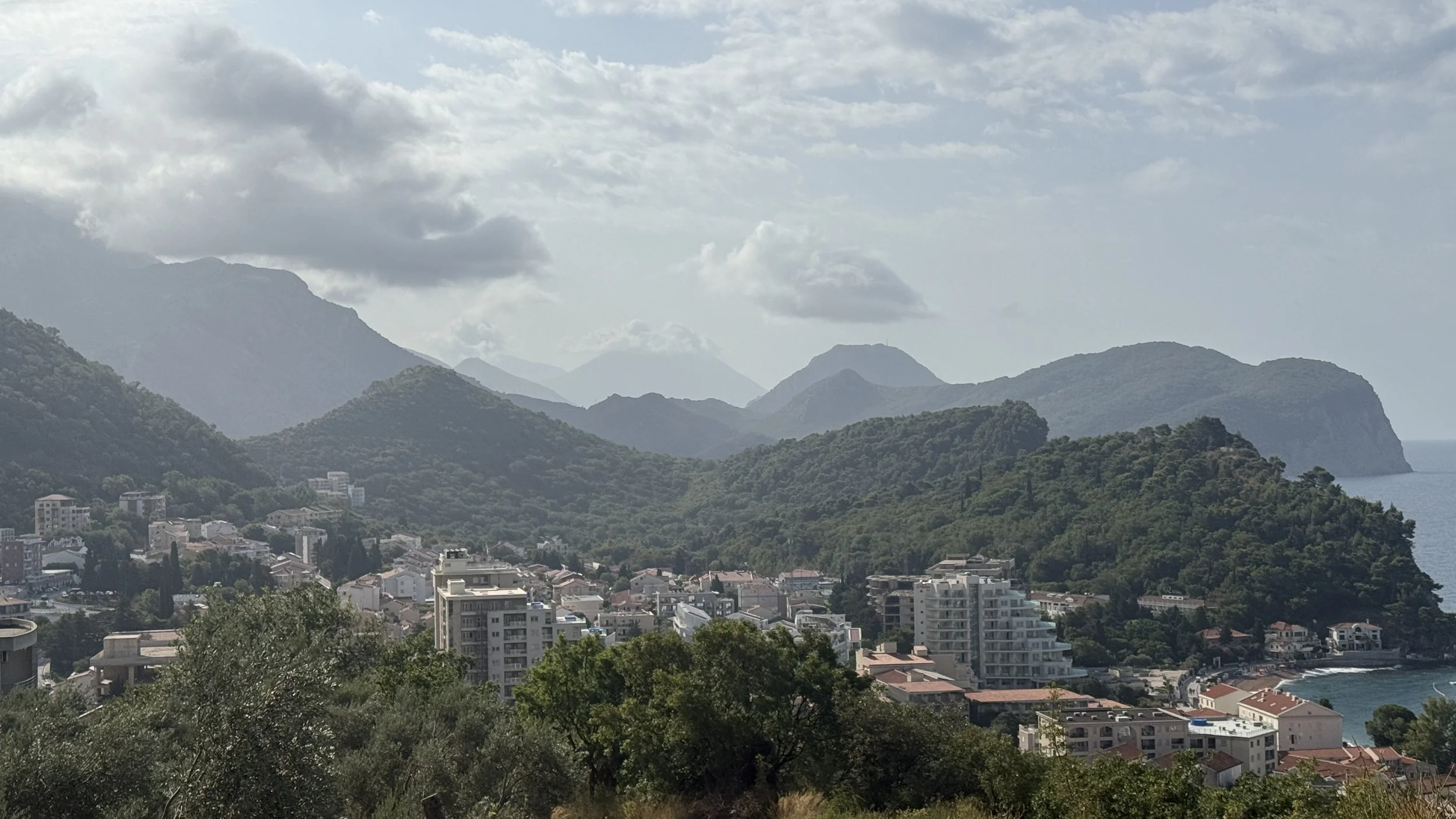Day 76 - July 27th: Inland
Becici to Dabezići: 31.1 miles / 2,155 total
We ended our day chaotically as Tina arrived shortly before me in Bečići. She’d been stuck in miles of standstill traffic that at least I was able to run through. Our apartment was tucked away in a crowded seaside zone with narrow streets and no parking, so Christina had to circle like a plane waiting for its landing slot. When I got there, I grabbed as much gear as I could—including Jax—so she could park nearly a kilometer away. A man who owned the restaurant on the street came out to help her locate the apartment. Then, as she was pulling away, she accidentally clipped his car. Upset and emotional, she returned a bit later with a gyro, a Coke, and a smirk. She had settled up with him for €145—he gave her back €5 and offered her dinner from his place. Only Christina!
We had a quick, quiet dinner right on the beach around 6 p.m. The beach was absolutely packed—not an inch of sand unclaimed. One thing’s for certain: the Slavs love their beach time. I also learned that anchovies in Montenegro come fully intact—bones and all. I usually crave them for the salt, but I couldn’t manage these. Jax, however, was thrilled.
I woke at 3:11 a.m. to thunder and lightning rattling outside our window. I remembered I had left my shoes out—my only pair in the apartment—so I jumped up to grab them. Rain came and went quickly, and by 6:15 a.m., I was on the road. The air was cool, promising a break from the searing heat of the past few weeks. Traffic was light as I eased back onto the coastal E65.
Montenegro continues to surprise me—massive uninhabited mountain ranges broken up by scattered coves and compact villages. It’s a small country of about 600,000 people with a long, layered history. Once part of the Roman Empire, then the Byzantine, it remained fiercely independent through the Ottoman era and was a kingdom in the early 20th century. After WWII it joined Yugoslavia and declared independence again in 2006. The name “Montenegro” means “Black Mountain” in Venetian, and the rugged terrain lives up to it.
As I made my way inland, my mind shifted to the final logistical puzzle: how we’d navigate Turkey. Rental restrictions, border issues, and safety considerations swirl in the background. We’ve started sketching plans—from taxi relays to solo runs or bringing in outside help—but the solution still hangs out there, waiting.
On top of the first climb out of Bečići, I passed through Katun Reževići, a small hilltop settlement that gave me spectacular views of the Adriatic below.
The terrain dropped again to the sea before another climb on a narrow ramp that led to the Monument to the Fallen Fighters at 20k. The views from there were vast.
Descending into the port town of Bar, I spotted tankers docked in its industrial harbor, but my eyes locked on something more striking: the golden dome of the Church of St. Jovan Vladimir. I had to see it. Built in 2016, the church honors the 11th-century prince of Duklja—modern-day southern Montenegro—and the country’s first Christian martyr and saint. The interior was bathed in amber light and iconography everywhere. It was one of the most distinctive churches I’ve seen.
After leaving Bar, I veered left and began the day’s biggest climb, 2,000 feet into the highlands. Around kilometer 46, I passed through Pečurice, a hillside village clinging to the mountains. Families tend olives and grapes on terraces their ancestors built.
As I climbed higher, I noticed Muslim cemeteries and minarets poking through the trees. At one roadside spring, I encountered a group of locals collecting water. I motioned to ask if it was drinkable, and they waved me to the front. It was ice cold and pure, straight from the mountain.
At exactly 50k, I heard honking—Christina and Jax had arrived. “We have a place!” she yelled. Relief. I jumped in, knowing we’re just 15k from the Albanian border. That’s tomorrow’s adventure.
Thanks for following along and the support.
Cheers,
David.




